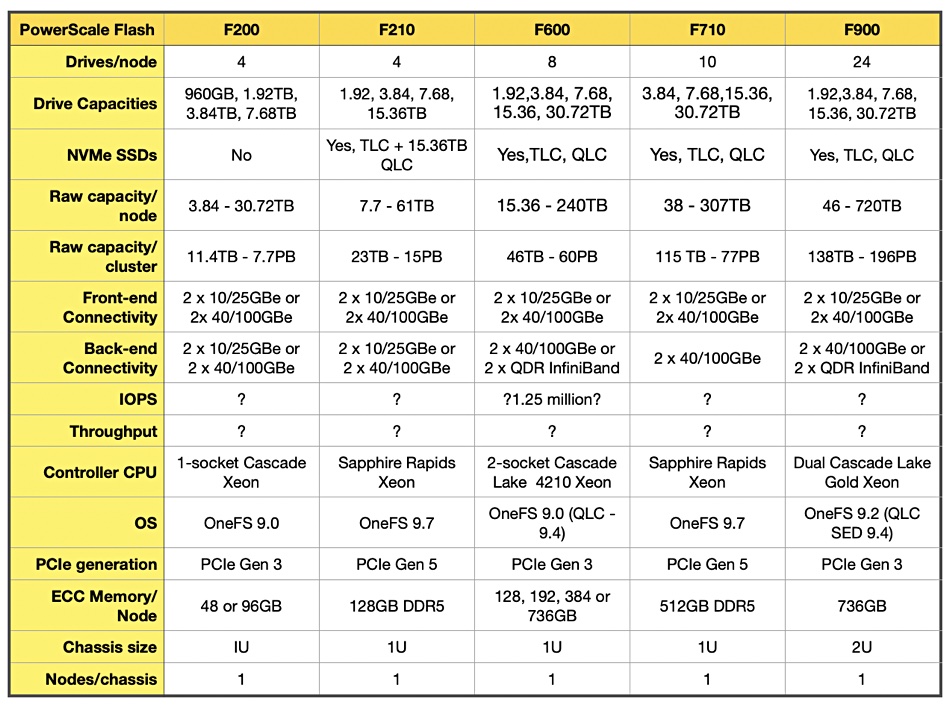Dell has upped its PowerScale scaleout filer game with two models featuring Sapphire Rapids Xeon controllers and PCIe 5 buses to move data faster around the system.
PowerScale systems are basically PowerEdge servers with directly attached storage, running the OneFS operating system. There were three PowerScale models: F200, F600 and F900. They all use the PCIe 3 bus and all-flash systems, with the F600 and F900 using the fastest NVMe drives. The F200 has a single socket Cascade Lake Xeon CPU, while the F600 has a twin-socket Cascade Lake 4210 CPU and the F900 faster dual Cascade Lake Gold Xeons. The new F210 and F710 systems use faster still Sapphire Rapids CPUs with DDR5 memory, and move up to the PCIe 5 bus, 4x faster than PCIe 3. All these systems can be clustered with from 3 to 252 nodes.
Dell’s Chris Mount, a program management director, blogged: “The F210 is the optimal platform for performance with small capacity requirements, whereas the F710 offers a balance of high performance and great capacity in 1RU.”
Both the new systems come in a 1RU chassis, the F210 supporting four drives (1.92, 3.84, 7.68 or 15.36TB) with the F710 accommodating up to ten drives and adding a 30.72TB SSD to the four capacities supported by the F210. Its raw capacity ranges from 38TB to 77TB while the smaller F210 holds from 7.7TB to 61TB. A table shows the main characteristics of each PowerScale model:

All the systems carry out inline compression and deduplication.
We’re told by Dell that the F710 has up 2.2x better streaming read and write performance than the F600 as well as an up to 2.6x improvement in high concurrency, latency-sensitive workloads, and up to 90 percent higher performance per watt. There is no performance comparison of the F210 versus the F200, but the F210 gets a 15.36TB QLC drive, which the older F200 does not support, effectively doubling its maximum capacity. The latest OneFS release, v9.7, is claimed to provide an up to 80 percent boost in storage performance over OneFS v9.4.
The new systems are classed as AI-ready and Dell describes the workload personality of the products like this:
- F200 – Remote offices, small M&E workloads, small hospitals, retail outlets, IoT, factory floor and other similar deployment scenarios;
- F210 – Entry-level AI and Analytics journey, and other high-demanding workloads that require a balance of performance and capacity;
- F600 – M&E studios, hospitals and financial service organizations that need performance and capacity for demanding workloads;
- F710 – Generative AI and AI workloads, high performing vertical workloads like media and entertainment, healthcare and life sciences, high frequency trading, and EDA workloads;
- F900 – Media and entertainment 8K, genomics, algorithmic trading, artificial intelligence, machine learning and HPC workloads.
We are looking forward to a PCIe 5/Sapphire Rapids refresh for the F600 and F900 systems, as that should send their performance rocketing up as well.
A quick comparison shows PowerScale competitor Qumulo available with HPE all-NVMe Alletra 4110 PCIe 5 nodes. These come in three flavors: HPE 38T with 10x 3.84TB drives, HPE 153T with 20x 7.68TB drives, and HPE 307T with 20x 15.36TB drives. The drive choice is restricted compared to Dell’s offering. The model number is the raw storage capacity. All three have a 1RU chassis with dual Sapphire Rapids 4410Y 12-core processors, and 4x 100GBe connectivity. They can be positioned against Dell’s F210, F600 and F710 respectively. The 153T may out-perform the PowerScale F600 because of its slower CPU and bus. Qumulo clusters can scale up to 265 nodes.
There is more information about the two new PowerScale systems available via a spec sheet and on Dell’s PowerScale web page.








